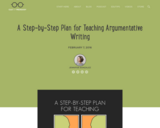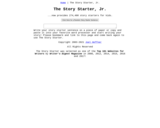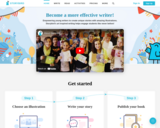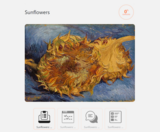
7 steps to teaching persuasive or argumentative writing!
- Subject:
- English Language Arts
- Material Type:
- Activity/Lab
- Podcast
- Author:
- Jennfier Gonzalez
- Date Added:
- 05/17/2019

This is a collection of resources for writing instruction.

7 steps to teaching persuasive or argumentative writing!

This folktale is about three monks who visit a village filled with unhappy people. The villagers do not welcome the monks, so the three monks decide to make stone soup to teach the villagers a lesson in happiness.

Julian meets Gloria, a new girl in his neighborhood. Together they make a wish kite, with wishes fastened to its tail; both wish for lasting friendship.

This African folk tale explains how many African tales came to be known as ŕSpider stories.ĚŇ In this tale, Ananse, the Spider man, travels up to the sky to offer to buy Nyame, the Sky Gods, stories. Nyame asks Ananse to bring him Osebo the leopard-of-the-terrible-teeth, Mmboro the hornets-who-sting-like-fire, and Mmoatia the fairy-whom-men-never-see. Ananse agrees to the price but Nyame believes that Ananse is too small and weak to accomplish such a task. Ananse uses his intelligence and cunning to trick all three creatures. He returns to Nyame with payment for his stories. Nyame calls his court together to sing the praises of Ananse and declares his stories ŕSpider stories.ĚŇ

This site generates 274,400 story starters for kids to give them lots of opportunities to write!

Storytelling/Story Acting (STSA) is a simple movement based on the work of Vivian Paley. STSA involves children dictating stories to adults, followed by a teacher-facilitated acting out of children’s stories at meeting times throughout the day. STSA develops narrative fluency, the concept of a story, and the opportunity to express emotions and experiences. There is no need for rehearsal or special props and stories can be acted out anywhere. It is however, important to designate a “stage” and develop a routine around STSA.

Storybird lets anyone make visual stories in seconds. We curate artwork from illustrators and animators around the world and inspire writers of any age to turn those images into fresh stories. It's a simple idea that has attracted millions of writers, readers, and artists to our platform. Families and friends, teachers and students, and amateurs and professionals have created more than 5 million stories—making Storybird one of the world's largest storytelling communities
Publish, print, and share your writing.
Order beautiful printed editions of your stories or publish online and get feedback from a community of 9 million readers, writers, and educators.*
If you are going to use this site for children to read books - we suggest you preview them first!

This lesson provides teachers with support for using text-dependent questions and Common Core literacy strategies to help students derive big ideas and key understandings while developing vocabulary using the illustrated text, "The Stranger." This story uses a mixture of pictures and words to explore the idea of the changes of the seasons and the expected natural events that occur with it' colder weather, leaves changing color, Jack Frost and migration. Chris Van Allsburg walks a fine line between reality and fantasy to create a mystery about the identity of the stranger who will represent the seasonal change from summer to fall. The Houghton Mifflin authors identify the storyĺĺs theme as an allegory for autumn and the use of personification to make the association.

This lesson for English Language Learners (ELLs) discusses the physical effects of stress on the human body. In this lesson, learners will practice reading, listening, speaking and writing. All activities are automatically graded with feedback provided to the learner upon submission.

This is a Zuni play about an ant in the search to find out who is strongest of all. The ant talks with numerous characters to find out who is the strongest. At the end, he learns the lesson that everything is stronger than something else.

This process and template provide teachers with a structure to infuse structured literacy cross-curricularly. This includes a 9 step process, as well as a template to plan on, and an example.

This is a series of toolkits for older students.
The toolkits allow students to explore a topic, watch videos on the content, and apply what they learn.
Topics include:
Interacting with profs, library skills, managing your time, preparing for exams, presentation skills, reading textbooks, taking notes, thinking critically, working in groups, and writing.

"This printable is super simple (my favorite). It’s a summarizing graphic organizer with space for students to write notes about characters (“somebody”), conflict (“wanted” and “but”), rising action, climax and resolution (“so” and “then”). I’ve found that some of my students have a hard time condensing a story. They want to tell more than they need to for a summary. Encouraging them to follow this kind of statement helps limit them to only the most important ideas."

This lesson for English Language Learners (ELLs) introduces a series of paintings by Vincent Van Gogh that have become famous throughout the world, Sunflowers. In this lesson, learners will practice reading, listening, speaking and writing. All activities are automatically graded with feedback provided to the learner upon submission.

Daily lessons and educational activities that kids can do on their own . Topics include reading, writing, science and math, health, language, art, music, fun and games.

The following modules are available for download:
*Module 1 - Multi-Level Instruction - Planning for Student Diversity
*Module 2 - Reading Instruction - Critical Elements
*Module 3 - Instruction in Mathematics - Effective Instructional Practices
*Module 4 - Written Expression - Effective Instructional Practices
On y trouve trois modules de disponibles en français:
*Module 2 : Instruction en lecture - Éléments essentiels
*Module 3 : Instruction en mathématiques - Pratiques pédagogiques efficaces
*Module 4 : Expression écrite - Pratiques pédagogiques efficaces

This lesson for English Language Learners (ELLs) introduces the traditional food of Japan, sushi. In this lesson, learners will practice reading, listening, speaking and writing. All activities are automatically graded with feedback provided to the learner upon submission.

This lesson for English Language Learners (ELLs) introduces the traditional Japanese art of sword making. In this lesson, learners will practice reading, listening, speaking and writing. All activities are automatically graded with feedback provided to the learner upon submission.

Glashka uses her innate connection and intuition with nature to help bring together the community in hopes of trying to save the lives of the trapped Beluga whales, who have swam into the freezing channel

A systematic approach to teaching writing in grades 1-3. This includes many links and information about the curriculum at a glance, required products, and identified skills. It also contains the Writing Revolution scope and sequences. This shows scope and sequence for these early years as well as gives you a list of resources for your classroom.